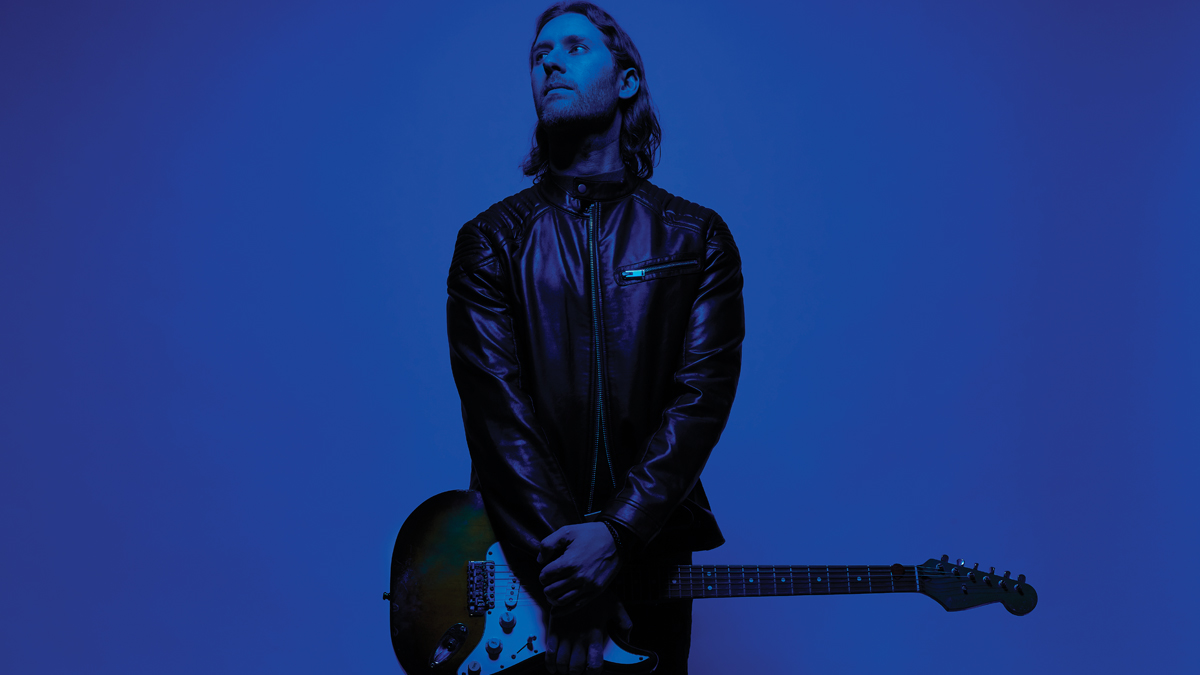Nir Felder on Removing the Boundary Between Pop and Bop, Practicing for Improv, and the Beauty of Open Strings
Ignoring genre, Felder draws freely from blues-rock and jazz for two discs of expressive, inventive guitar playing.

To hear Nir Felder, you wouldn’t imagine the first players to excite him were Clapton, Hendrix, and Page. His minimal string bending and long, high-speed, harmonically complex lines make it hard to trace his roots to that rock triumvirate.
It’s only his almost exclusive use of a Fender Stratocaster and decidedly non-bebop attack that provide some hint.
“Those were the guitar heroes who brought me to the blues,” Felder says. “That was a road map for how the guitar could express things in a way I had been unable to. I didn’t have the language for it. Playing blues was cathartic.”
It’s also the reason he still plays the ’95 Tex-Mex Strat he has had since he was 13 years old. “I wanted to play a Strat, like Stevie Ray,” he says. Felder’s path ultimately led him away from blues and rock toward jazz and pop.
His résumé includes stints with Erykah Badu, Terri Lyne Carrington, Jack DeJohnette, Brad Mehldau, Meshell Ndegeocello, Chaka Khan, and even an appearance on Broadway star Ben Platt’s Netflix special, Live from Radio City Music Hall, as a member of his band.
The tracks he recently recorded may recall Pat Metheny more than Pat Hare, but Felder’s tone and attack remain more blues bar than fern bar. Those sessions yielded enough songs for two records: II (Ropeadope), which is out now, and 2.1, to be released later this year. Felder spoke with us about tone and his catholic approach to musical styles.
Who or what influenced your shift from blues into jazz-oriented harmony and improvisation?
John Scofield’s A Go Go record was important. I could understand the chord progressions and relate to his sound, but he was playing all this other stuff. Jimmy Herring and Wayne Krantz were also a bridge between blues-rock and jazz. When I went to Berklee, it became less about guitar. I tried to look at everything beyond the notes: The arc of the solo, and how to tell the story.
Some of your tunes sound more like pop, and some lean more toward jazz.
Both come out when I compose. I continue to love playing pop music. For example, on the Ben Platt special, I focus on textures and accompaniment. When I play jazz, nothing changes. I’m telling different stories but still conveying the narrative to an audience.
Your chord strumming with open strings sometimes recalls modern pop and other times Pat Metheny. Was he an influence?
I relate to his love of what the guitar does well. As jazz musicians, we are often told to make our instrument sound like a horn or a piano. But I think the instrument shines doing what it does best, be that string bends, the percussive quality, or the ringing of open strings. I love open strings because they resonate, but they also tell you, “We’re playing a guitar now.”
You use open strings in your single lines as well. Do you work that out, or have you reached the point where you can grab an open string as easily as a fretted note?
It wouldn’t serve me to work out a particular line. But to get to the point of being able to incorporate open strings, I work at getting comfortable doing it on the fly.
What practice regimen did you use to get to the level of speed and cleanliness with which you play?
For a year or so I focused on how to pick up and down, or up on upbeats and down on downbeats. Since then, it’s more about just playing. If I want to challenge myself, I try to play an up-tempo song. Exercises don’t work because the content is always changing.
If I learn how to play one exercise really fast, it won’t necessarily translate to being able to play improvised music fast. What you practice ends up being what you play. When I practice, the goal is to make it sound as good to me as if I were on a gig.

Getting back to your Strat: Are those the original pickups?
Everything’s original. I think I’ve had one fret job and changed the tuners at some point, but that’s it.
Given your use of heavy strings and percussive style, it is interesting you’ve needed only one fret job.
I play percussively but lightly in terms of finger pressure and the pressure of the pick. If you play hard, there’s nowhere to go. I always want to have expressive things I can do. That might have helped preserve the frets.
By keeping the volume between four and seven, I can play with the breakup and the volume. Right on the edge is the warm place I like
To that end, do you set your amp on the louder side?
The amp is relatively loud, and there are pedals driving it, but the volume of the guitar is rolled down. I’m at the edge of breakup.
If I were to turn my volume up to 10, it would be way too loud and broken up. By keeping the volume between four and seven, I can play with the breakup and the volume. Right on the edge is the warm place I like.
You do get a very warm sound for a Strat neck pickup.
When they designed this Strat, they didn’t know which pickups they would put in future models, so instead of just carving out pickup cavities they carved what they call “the bathtub,” making it somewhat hollow. Also, I think some of the sharp edges of the tone wore off from playing that guitar for 20 years.
Do you use a standard set of .013s?
I use D’Addario NYXLs. The only thing I change is using an unwound .026 G string.
What are you using to boost the amp?
Around 2006, I got a Keeley-modified Tube Screamer and haven’t shut it off since. I’ve been using the Klon KTR as my second boost. I have them both on at all times. I also can’t say enough great things about Jesse Davey’s KingTone stuff. I have the Duellist, the Blues Power, and the Octaland pedals. For the Netflix special, I used the Octaland and the Blues Power pedals.
Why two pedals?
Trial and error: One is not enough, three is too many. It’s all about the combination of pedals and their order in your single chain. It might only work for one person. You could put my exact pedalboard, amp, and guitar in someone else’s hands and it’s not going to work. It’s all about how they hit the instrument, with what strings and what pick.
Speaking of that, what pick do you use?
I like Jim Dunlop Jazz III picks. I haven’t been able to find anything better.
'Mallets' was written as a challenge to learn how to compose and improvise in cluster dyads, like major and minor seconds
Do you use the point or side?
I use the point, but I like them better when they’re a little worn down.
What do you use when you can use the amp you like?
My favorite is my old 50-watt Plexi Marshall. I don’t take it out of the house much because it’s heavy and fragile. I usually bring my preferred backline amp, which is a Fender ’65 Deluxe reissue. It is easy to find the spot where the Deluxe starts to break up without playing too loud. Maybe for outdoor gigs a Twin would be better.
What’s creating that leaping octave sound at the start of “The Longest Star”?
The Meris Ottobit. Everything they make is awesome. I use that throughout the song.
The sound on “Coronation” is a little more broken up than your usual tone.
It’s the Marshall going into this Swanson, open-back 2x12 Greenback cabinet I borrowed from Adam Rogers. He keeps it at the 55 Bar [in New York City]. I recorded with that and my Deluxe. I think “Coronation” favored the Marshall.
“Fire in August” has some textural chord stabs. How did you get that sound?
I think that’s a Meris Polymoon. It’s delay based, but comes with a lot of unique parameters.
On 2.1, “Mallets” features some close intervals. Were you playing those or is that some sort of effect?
That’s all played live. That song was written as a challenge to learn how to compose and improvise in cluster dyads, like major and minor seconds.
Some pop musicians are more jazz than some jazz musicians without knowing it
What situations do you most enjoy playing in?
That’s a great question. I like it when I’m encouraged to be myself within the parameters of the gig and can come from a fresh perspective every night. With Ben Platt, we always play the same set, we’re on a click, and there are certain things that need to happen.
Still, I can breathe new life into it every night because the people I’m playing with listen to each other. You’d think it’d be easier to do that playing jazz because it’s so improvisatory, but it’s not always the case. It depends on the players. Some pop musicians are more jazz than some jazz musicians without knowing it.
Even if they don’t know the harmony or the rhythms of jazz, they are always listening, open and in the moment. Some jazz musicians have all the vocabulary, chops, and know all the songs, but they play it the same way every time. To me, that’s not jazz.
- Nir Felder's new album, II, is out now via Ropeadope.
Get The Pick Newsletter
All the latest guitar news, interviews, lessons, reviews, deals and more, direct to your inbox!
"Get off the stage!" The time Carlos Santana picked a fight with Kiss bassist Gene Simmons and caused one of the guitar world's strangest feuds
“It’s a special kind of moment when you hit that first note of a solo and you literally get nothing.” He’s played with David Bowie and the Cure, but Reeves Gabrels says things don’t always go right, even for the pros










